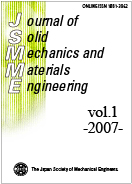Volume 1, Issue 1
Displaying 1-15 of 15 articles from this issue
- |<
- <
- 1
- >
- >|
-
2007 Volume 1 Issue 1 Pages 1
Published: 2007
Released on J-STAGE: January 31, 2007
Download PDF (132K)
Editorial
-
2007 Volume 1 Issue 1 Pages 2
Published: 2007
Released on J-STAGE: January 31, 2007
Download PDF (142K)
Reviews
-
2007 Volume 1 Issue 1 Pages 3-17
Published: 2007
Released on J-STAGE: January 31, 2007
Download PDF (1075K) -
2007 Volume 1 Issue 1 Pages 18-34
Published: 2007
Released on J-STAGE: January 31, 2007
Download PDF (603K)
Papers
-
2007 Volume 1 Issue 1 Pages 35-46
Published: 2007
Released on J-STAGE: January 31, 2007
Download PDF (1021K) -
2007 Volume 1 Issue 1 Pages 47-57
Published: 2007
Released on J-STAGE: January 31, 2007
Download PDF (989K) -
2007 Volume 1 Issue 1 Pages 58-68
Published: 2007
Released on J-STAGE: January 31, 2007
Download PDF (437K) -
2007 Volume 1 Issue 1 Pages 69-80
Published: 2007
Released on J-STAGE: January 31, 2007
Download PDF (1865K) -
2007 Volume 1 Issue 1 Pages 81-92
Published: 2007
Released on J-STAGE: January 31, 2007
Download PDF (499K) -
2007 Volume 1 Issue 1 Pages 93-101
Published: 2007
Released on J-STAGE: January 31, 2007
Download PDF (473K) -
2007 Volume 1 Issue 1 Pages 102-113
Published: 2007
Released on J-STAGE: January 31, 2007
Download PDF (655K) -
2007 Volume 1 Issue 1 Pages 114-125
Published: 2007
Released on J-STAGE: January 31, 2007
Download PDF (977K) -
2007 Volume 1 Issue 1 Pages 126-139
Published: 2007
Released on J-STAGE: January 31, 2007
Download PDF (1430K) -
2007 Volume 1 Issue 1 Pages 140-151
Published: 2007
Released on J-STAGE: January 31, 2007
Download PDF (504K)
Errata
-
2007 Volume 1 Issue 1 Pages E01
Published: 2007
Released on J-STAGE: April 19, 2007
Download PDF (1259K)
- |<
- <
- 1
- >
- >|
